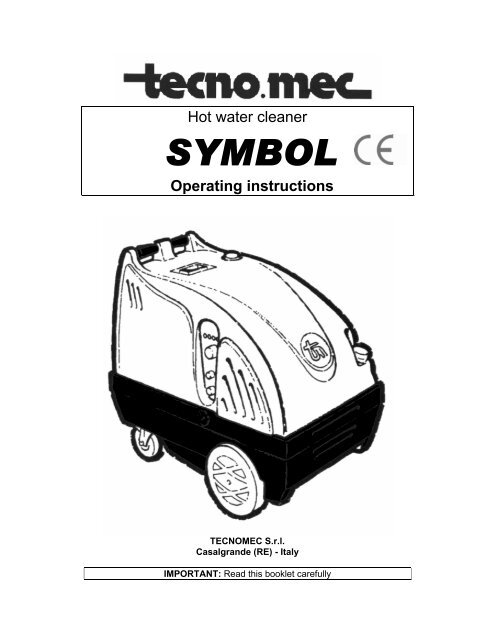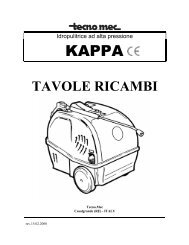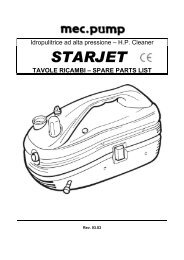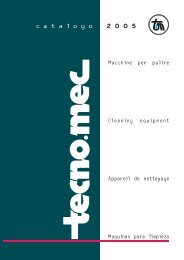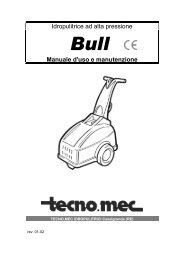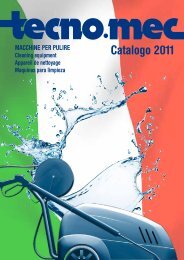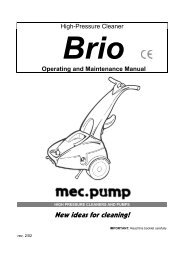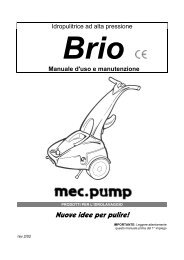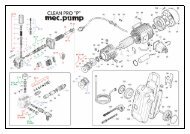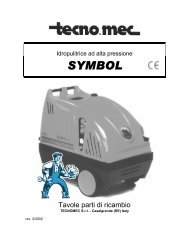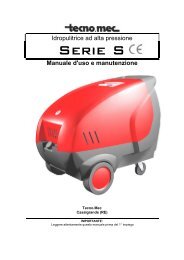Hot water cleaner Operating instructions - High pressure washers
Hot water cleaner Operating instructions - High pressure washers
Hot water cleaner Operating instructions - High pressure washers
Create successful ePaper yourself
Turn your PDF publications into a flip-book with our unique Google optimized e-Paper software.
HOT WATER HIGH PRESSURE CLEANERSYMBOLCongratulations, you have chosen a <strong>cleaner</strong> of high quality and great performance.The SYMBOL hot <strong>water</strong> <strong>cleaner</strong> will assist you professionally for all washing, descaling,cleaning and sandblasting purposes.SYMBOL <strong>cleaner</strong>s are recommended for use in all fields of industry, agriculture, buildingindustry and tourism.SYMBOL can give you an answer to all your cleaning requirements both hobby andprofessional because it is light and handy, easy to use and easy to maintain.The large range of versions perfectly fit each kind of use.DESCRIPTION OF THE MACHINESYMBOL is a cold and hot <strong>water</strong> high <strong>pressure</strong> <strong>cleaner</strong> formed by a metal chassis with wheelsand a handle for moving; generator for the production of hot <strong>water</strong>; gas-oil burner; gas-oil tank;duct for exhaust smokes; motor-pump for inlet of pressurized <strong>water</strong>,electric system with plug; power cable and electric board for control; cover and washing lancewith gun (or other accessories).CONDITIONS OF USEUSEThe <strong>cleaner</strong> has been designed and manufactured for the use in car-washing, body-shops,industries, filling stations, farms, etc.If the machine is used in closed rooms proper aeration and a good exhaust system isnecessary to avoid the risk of poisoning. To correctly execute these <strong>instructions</strong>, please contactour authorised technical service center.ENVIRONMENTThe electric plant IP 54 allows to use the machine-OUTSIDE ON SMOOTH SURFACES-IN A DAMP ENVIRONMENTIn all cases, to assure easy and safe manual handling it is necessary for the floor to be assmooth as possible.The machine has not been designed to be pulled or towed trained bymechanical devices.TECHNICAL FEATURESModelMax.<strong>pressure</strong>CapacityMotor powerOutlet <strong>water</strong>max. temp.(Psi) (Gp.m) (KW) (°F) (Gal.) (Volt-Hertz)Symbol 110/11 M. 1600 2,9 2,2 285 5,2 220-50Symbol 110/11 T. 1600 2,9 2,2 285 5,2 380-50Symbol 150/15 2200 4 4 285 5,2 380-50Symbol 200/15 2900 4 5,5 285 5,2 380-50Symbol 200/21 2900 5,5 7,4 285 5,2 380-50Symbol 150/21 2200 5,5 5,5 285 5,2 380-50Fuel tankVolt3
GENERAL VIEW1) Washing lance2) Gun/hose pipe fitting3) Quick connection4) Water feeding hose5) Water feeding pipe fitting6) Electric cable7) Detrgent tap8) “DETERGENT” label9) “BAR” label10) “Technical specification plate11) “MODEL” label12) “EC” label13) “Pressure gauge14) Control board15) Exaust smoke device16) Detergent tank17) “WARNING” label18) Handles19) Cover20) General switch21) Fuel tank22) Rotating wheel with brake4
MARKING AND IDENTIFICATIONCONFORMITY DECLARATIONTHE MANUFACTURERTecno.Mec SrlVia Canale, 114 - Loc. Villalunga42013 CASALGRANDE (RE) - ITALYDECLARES THAT THE PRODUCTS:WATER CLEANERSSYMBOLTO WHICH THIS DECLARATION REFERS, SATISFY THE FOLLOWING DIRECTIVES :98/37/CE - 73/23/CEE - 89/336/CEE - 93/68/CEETecno.Mec SrlManaging directorMELIGA PIER PAOLO6
INSTALLATIONThis operation must be done in clean and well-lit rooms.1) Remove the packing carefully and inspect the machine for damage which may have occuredduring transport. In case of doubt, do not use the machineand contact the after-sales service.The packing elements (cardboard, wood,etc.) must be put on a suitable dump andnever left within reach of children who couldbe injured.2) Put the <strong>cleaner</strong> on a properly arrangedplace, in any case on a smooth surface,acting on the brake pedal of the rotatingwheel (FIG. B/22) block up the machine.The work station must be equipped with:- a current tap 400V/16A 3+PE(230V for single-phase version)- a <strong>water</strong> plug 1/2”, <strong>pressure</strong> 0.3 Mpa, withanon-off valve- a connection to the drainage system for thetreatment of the waste <strong>water</strong>.- Prearrange a device for the elimination ofexhaust gas as gas released in closedrooms is dangerous, and properly air theroom.3) Connect the <strong>water</strong> feeding hose to thetap, this connection must be done with asuitable flexible hose which must be asshort as possible to avoid stumbling.4) After having unscrewed the plug (FIG.B/21) fill the tank with diesel.It is necessary to use clean fuel, filter it ifnecessary.5) Connect the lance (FIG. A/1) to the hose(FIG. A/2).Connect this one to the fitting (FIG. A/3)6) Connect the <strong>water</strong> feeding to the quick connection (FIG. A/5) fixing it with a hose clamp. Thefeeding hose must be perfectly clean inside, use a filter upstream if necessary.7) Before doing the electric connections turn the main switch (FIG. B/20) onto OFF position andbe sure that the indications on the label (FIG. A/10) correspond to those of the electrical mains.The installation must be done by qualified persons according to national and local rules.8) Verify that the section of the cables, their serviceability and their capacity is suitable for thedrawn power as indicated on the rating plate.It is important to protect the supply line using thermo-magnetic devices, coordinated with thethermo-magnetic device of the machine. The features are indicated on the device.9) The connection with the electrical mains must be done using taps complying with IEC 309rule and without using extensions.7
10) The unit is safe only when it is correctly connected with a grounded plant and in presence ofan automatic cutout device able to grant a voltage contact not higher than 25V. Use a circuitbreaker corresponding to
CAUTION: high <strong>pressure</strong> jet of <strong>water</strong>. Grip the lance with both hands.Never direct the jet of <strong>water</strong> towardpeople or animals.TO START THE MACHINE IT IS NECESSARY TO FOLLOW THE FOLLOWING SEQUENCE:1) STARTING STAGESA) Turn on the <strong>water</strong>B) Set to zero the <strong>pressure</strong> by turning theregulating knob on the lance (whenpresent). The <strong>pressure</strong> is indicated bythe <strong>pressure</strong> gauge (FIG. C/7)C) Press the starting switch ON(FIG. C/5)CAUTION: grip the lance and thespray gun with both handsD) Hold the gun in the open position for afew seconds to allow the air to escape from the hoses.E) At this point adjust the machine to your <strong>pressure</strong> requirement by turning the <strong>pressure</strong>regulating knob on the lance (when present)F) Select the temperature of the <strong>water</strong> by turning the starting knob of the burner(FIG. C/4). In position 0 the burner is OFF and <strong>water</strong> is cold2) USEThe machine can (by low <strong>pressure</strong> or even by high <strong>pressure</strong> according to models - see table“Equipment”) suck and mix detergents or other liquid chemicals (not corrosive) thanks to anautomatic device.The machine is equipped with a detergent suction hose with filter (FIG. A/16)The quantity of detergent can be regulated by turning the intake knob (FIG. A/7)We suggest proceding in the following way:- distribute the detergent on the surface to be cleaned- stop the delivery and wait 3-4 minutes- start the hot jet of <strong>water</strong>To avoid chemical deposits building up we suggest to clean the chemical suction kit by sucking<strong>water</strong> for a few seconds.When the fuel inside the burner (gas-oil) reaches the minimum level, the warning light for lack ofgas-oil (2) lights up (only on prepared machines). In this case fill the gas-oil tank (FIG. B/21)9
If the burner does not start the warning light “burner lock” (FIG. C/1) lights up. In this case turnthe burner adjusting knob (FIG. C/4) up to 0 and wait at least 20 seconds before trying to restartthe burner.3) SWITCHING OFFWhen finished using the machine act as follows:A) Close the spray gunB) Turn the knob (FIG. C/4) up to 0 (burner OFF)C) Open the spray gun and let <strong>water</strong> flow for about one minute (until the temperature lowersand cold <strong>water</strong> comes out).CAUTION: be sure that <strong>water</strong> is cold before stoping the machineD) Press the OFF switch (FIG. C/6)E) Turn off the <strong>water</strong> tapF) Open the spray gun for a few seconds to allow the <strong>water</strong> tocome out of the hosesG) When finished using the machine disconnect electrical and <strong>water</strong> mains and putthe machine away in a closed room.FORBIDDEN OPERATIONS - SAFETY REGULATIONS- Do not obstruct the high <strong>pressure</strong> hose,it could explode causing damage to theoperator- When the machine is working, nevertake away the cover of the internalequipment- When machine is running, it generatesheat, so touch it only when it cools down- Do not pull the machine by its electricalcable or by the <strong>water</strong> hose- Do not use the electrical plug to executethe starting and switching off stages- Do not use the machine on tiltedsurfaces- Do not use the machine bare-footed10
- Do not touch the exaust device until it is completely cool- Never leave the machine unattended when it is running. In case of long stops it iscompulsory to switch it off.- To protect against parts rebounding, it is necessary to wear protective clothes(especially during sandblasting or descaling operations, etc.)- If the machine is used in a danger zone (for example petrol pumps) act according to thesafety rules- Thanks to a safety device, themachine automatically stops if it isinactive for more than one minute. Touse it again, it is enough to open thespray gun- Do not store the unit in closed rooms orin places with insufficient ventilation. Themachine must have the possibility to blowoff gas exaust and to restore air- Do not repair or adjust the working unitbefore switching off the power anddisconnecting the plug from the electricalnetwork11
- Do not make repairs on, or do damage tothe electrical cable- Avoid using the extension, or use extensionsaccording to rules to avoid damages to theoperator- Do not direct the jet of <strong>water</strong> on the unit orany other electrical parts and appliances.It can damage the electrical system, it isespecially dangerous for the operator.- Protect the machine from atmosphericagents by not working with the unit in the rainor any other situation in which liquids caninfilterate into the pump- Do not place heavy objects on the cover ofthe machine. It could be damaged.12
- Do not obstruct the exaust device- Avoid using the pump without <strong>water</strong>; it coulddamage the internal parts of the pump.WARNINGIf the machine is out of order or in the case of bad operation, immediately switch off themachine by means of the main switch, and advise the qualified personnel. Switch off themachine and disconnect the <strong>water</strong> and electrical mains and do not effect any repair.Immediately contact qualified personnel. The repairs must be done by the manufacturer or byan authorised after-sales center, always using original spare parts.MAINTENANCEThe following operations must be done to avoid damage to mechanical parts and to keep your<strong>cleaner</strong> efficient.1) Check that the oil level is always over the dipstick cut. Change the oil after 50 workinghours, use oil type SAE 20/30. To check the oil level, unscrew the handles (FIG. A/18)of the machine, unscrew the cap of the detergent tank (FIG. A/16) and the cap of thegas-oil tank (FIG. B/21), then lift the cover (FIG. A/19). Now check that the oil levelinside the high <strong>pressure</strong> pump covers at least half of the oil window of the pump (orunscrew the oil cap and verify that the oil covers the lower cut). If the quantity of oil isnot enough, do not start the machine.2) Do not expose the unit to low temperatures. Intense cold may damage the pump andseriously harm other circuits. In case of long stops in temperatures lower than 0°Cempty the circuits. Vice versa, high temperatures may overload the motor.3) When the machine has been stored for a long time, there is a possibility of calciumdeposits building up. This could make instant starting difficult. In this case to avoid theconsequences of electrical over charging, before plugging the unit in, we suggestturning the motor shaft with a screwdriver (important: disconnect the machine beforedoing this operation). So you will know the cause of the locking (frost, incrustations, orothers) and you will be able to behave consequently.4) Never intake corrosive liquids (paints, acids solvents, oily or very thick liquids) whichcould permanently damage the pump. To avoid chemical deposits building up wesuggest cleaning the chemical suction kit by sucking <strong>water</strong> for a few seconds.5) From time to time check the coil; it is enough to take off the lance nozzle and letthe pump run. Than verify that <strong>pressure</strong> on the <strong>pressure</strong> gauge does not exceed40 bars. If it is higher, it is necessary to clean the coil as follows (IMPORTANT: on theSYMBOL METAL the coil must be cleaned by qualified personnel):- fill the chemical tank (FIG. A/16) with about 2 Kg. of descaling liquid- take off the lance nozzle- open the detergent intake regulator (FIG. A/7)13
- now let the pump work and open the spray gun for a few seconds to allow thecirculation of the liquid and verify it flows from the lance- to make the descaling easier let the burner operate for about 30 seconds- stop the machine for about 3-4 minutes- operate the pump, open the spray gun and let all the descaling liquid flow- close the detergent intake regulator- rinse putting clean <strong>water</strong> into circulationCAUTION: the descaling liquid contains acid substances which could damage theobjects to be cleaned: Be sure to have correctly rinsed them.- carefully clean the detergent tank filling with clean <strong>water</strong>- clean the lance nozzle and retighten it6) From time to time check the wear of electrodes, the right distance from one end to theother is 3 mm.7) Replace the high <strong>pressure</strong> <strong>water</strong> hose every 2 working years or when it is necessary.Before use verify that the <strong>pressure</strong> features of the new hose correspond to those of themachine.DEMOLITION OF THE MACHINEWhen you decide to discard the machine it is necessary to make it inactive:- disconnect from the electrical mains- cut the external electric cable- cut the motor cable- take away the wheels- empty the inner tanksECOLOGICAL INFORMATION:The elimination of waste arising from demolition of the machine must be carried out in a mannerwhich does not pollute ground, <strong>water</strong> and air. Consult your local laws for more information.DISCARDING WASTE MATERIALS:- Ferrous materials, aluminium, copper are recyclable and must be brought to anauthorised collecting center- Plastic materials must be carried to a proper recycling center (if one exists for suchpurposes) or to a dump or burning center- Exausted oils must be brought to an authorised collecting center.Technical features of the product can be modified by the manufacturer at any time.14
TROUBLESHOOTINGIn case of operating difficulties, please check the following table. If difficulties persist, contact atechnician authorised by the manufacturer.WARNING: Before doing any kind of maintenance, disconnect the machine from theelectric mainsFAULT CAUSE REMEDYPump running normally but <strong>pressure</strong> Pump sucking airOperate the pump with open lancedoes not achieve rated valuesValves worn or dirtyClean or replaceNozzle incorrect or wornCheck and replaceWorn piston packingCheck and replaceCloggy suction filterClean or replaceUnloader pin valveClean or replaceFluctuating <strong>pressure</strong> Valves worn, dirty or stuck Check, clean or replacePump sucking airCheck that hoses and fittings are air tightWorn piston packingCheck and/or replacePressure drops Nozzle worn ReplaceValves dirtyCheck, clean or replaceUnloader valve pin worn or locked Check and/or replaceWorn piston packingCheck and/or replacePump noisy Pump sucking air Check that hose and fittings are air tightValves dirty, worn or lockedCheck, clean or replaceWorn bearingsCheck and/or replacePresence of <strong>water</strong> in oil Piston packing and oil seal worn Check and/or replaceWater dripping from pump head Piston packing worn ReplaceThe O rings of piston guide or retainer ReplacewornOil dripping Oil seal worn ReplaceThe motor does not start Plug not well connected Check plug, cable and switchLack of power supplyCheck plug, cable and switchThe motor hums but does not start The main voltage is insufficient, lowerthan the minimum requiredCheck that the mains power supply isadequateThe pump is locked or frozen Check by turning the motor manually (seeADVICE)Incorrect extension cableSee table INSTALLATIONThe motor stops suddenlyTripped thermal overload due to overheatingCheck that the main voltage correspond tothe specifications.Switch off the motor andlet it cool for a few minutesThe burner does not start Lack of gas-oil Check the gas-oil level and the floatElectrodes wornCheck (see MAINTENANCE)Electrodes damagedReplaceGas-oil filter obstructedReplaceGas-oil nozzle obstructedClean the burner nozzleFuse of the motor burner andtransformer damagedReplaceThe operations marked with the black square must be done only by qualified personnel15
16WIRING DIAGRAM - SYMBOL SINGLE-PHASE(SYMBOL 11/110M)
WIRING DIAGRAM - SYMBOL THREE-PHASE “A” VERSION (STANDARD)(SYMBOL 11/110T – 15/150 – 13/170)17
WIRING DIAGRAM - SYMBOL THREE-PHASE “B” VERSION(SYMBOL 15/200- 21/200 - 21/150)18
AUXILIARY WIRING DIAGRAM(ALL VERSIONS)WIRING DIAGRAMS LISTL1 – L2 – L3 = LINEQ1 = MAIN SWITCHK1 = PUMP SWITCHF1 = FUSE 1AF2 = FUSE 4AF3-F4 = FUSE BURNER/TAT 4AY1 = GAS OIL SOLENOID VALVEKT1 = GASOIL SOLENOID VALVE TIMERH1 = LINE LEDH2 = GAS OIL LACK LEDH3 = PUMP LEDU7 = ANTINOISE TAT FILTERSL1 = GAS OIL FLOATS1 = PRESSURE SWITCH (run)S2 = PRESSURE SWITCH (burner)ST1 = EXTERNAL THERMOSTAT with SWITCHS3 = THERMOSTAT (contact)K2 = BURNER RELAYKT2 = TOTAL STOP TIMERT2 = HIGH VOLTAGE TRANSFORMERT1 = TRANSFORMERMP = MOTORE POMPAMB = MOTORE BRUCIATOREARC212 = TOTAL STOP DEVICE19
MAIN INTERNAL VIEW1) Chassis 5) Fixed wheel 9) Electric motor2) Float 6) Vlave group 10) Boiler3) Rotating wheel 7) Fuel tank 11) Control board4) Water tank 8) <strong>High</strong> <strong>pressure</strong> pump 12) Detergent tankrev. 2/2002Via Canale, 114 - 42013 CASALGRANDE (RE) - ITALYTel. +39-0522-840805 Fax +39-0522-849962Internet: http://www.tecnomec.com20


